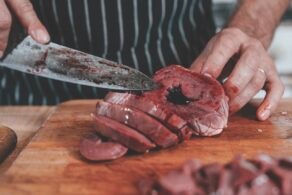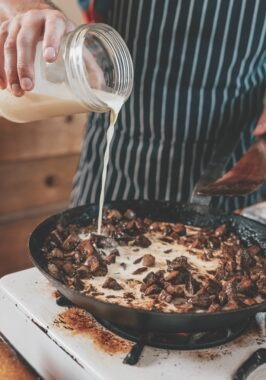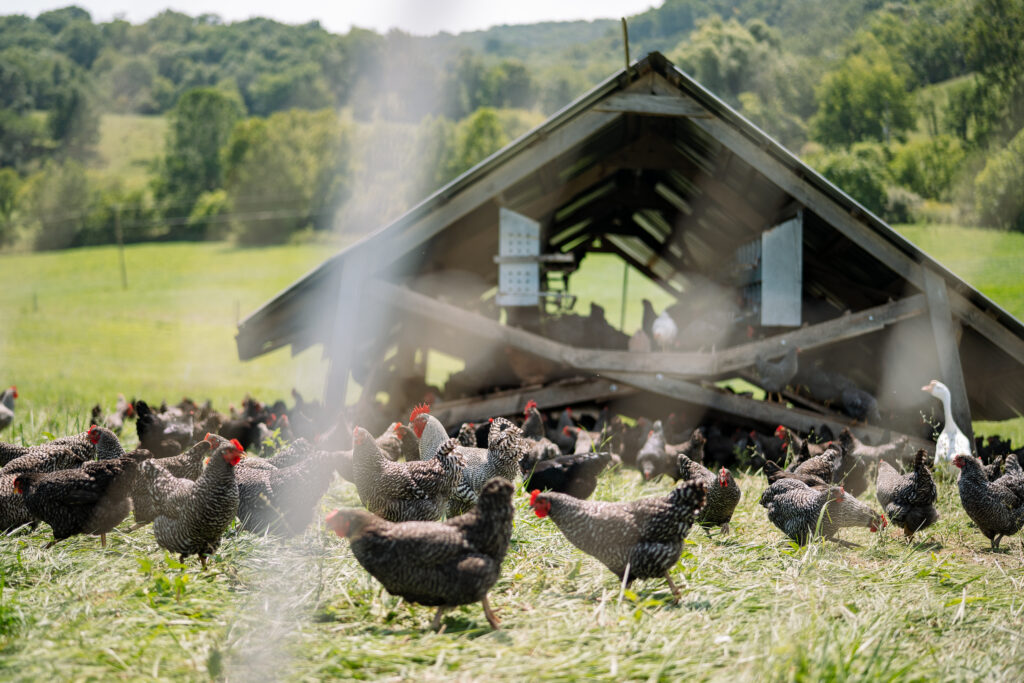The argument for offal usually focuses on nutrition. Certainly, offal provides nutrients that are unavailable elsewhere in such high concentration and digestible form, but the premise of the nutritional campaign for offal is that the flavor is lacking. Offal doesn’t taste well, so we must dutifully consume it while firmly holding our noses, or worse, reduce it to a pill or desiccated powder.
This is how we bypass the sense of taste, denying an elemental and distinctly human part of our nature. Unlike animals, we are not physically equipped with fangs and claws for acquiring our nutriment. Instead, we were given the power of reason. Therefore, any “food, not treated by art, is unbecoming” to man (Avicenna qtd. in Aquinas 78)1. Culinary art is the exclusive prowess of the rational soul. We eat pigs, but we do not eat like pigs. It is therefore not just our pleasure, but our nature to prepare offal well.
Our distaste for offal is learned, caused by artless offal cookery and bad provenance; it can therefore, be unlearned. The antidote is regularly preparing fresh offal in a manner more becoming to the “nobility of man’s nature” (Avicenna qtd. in Aquinas 78)1. Artfully prepared offal satisfies the entire person by feeding the soul as well as it nourishes the body.
What is Offal?
Etymologically, offal is exactly what it sounds like: that which “falls off” the carcass when opened. The cascade of intestines and internal organs are what make up offal. The lungs, sweetbreads (thyroid and pancreas), liver, kidneys, spleen, testicles, and brain are the soft-tissue organs. The stomach and both the small and large intestines and the bladder are offal too. The heart, the caul fat, and the skirt and hanger steaks make up the muscle and fatty tissue of offal meats. All these innards are known as the “fifth quarter” of the animal’s yield. On ruminants, the offal accounts for almost half the live-weight. In pigs and poultry, it is closer to one quarter of the live-weight. And it is all delicious.
This article will focus on the soft-tissue organ meats. The various tubes and sacs of the gastrointestinal tract have near limitless use and interest, so they will need a treatise of their own.
The organs can roughly be categorized by species. On a flavor scale ranging from mild to strong, the organs of poultry are at the beginning. The livers of chickens and waterfowl are delightfully mild and the most tender. As you move up the scale in flavor, you also get a gradual increase in toughness. Pork is next, but it often competes with poultry for the least potent slot on the scale. Next is goat and then sheep which brings an unmistakable caprine richness that you recognize as the distinct flavor of grass-fed lamb. Beef takes the top of the scale both in richness and toughness. This is due as much to the age of most cows at slaughter as it is to bovine physiology. The offal of milk-fed veal, for example, barely surpasses poultry in flavor intensity.
Regardless of species, the basic principle for tasty offal is freshness. We are, therefore, rightly repulsed by previously frozen morsels. The structure of soft-tissue offal is so delicate that the expansion of freezing water molecules utterly unknits them. Liver becomes pasty; kidneys turn rubbery. Even worse, offal stored for over a week (especially in a sealed bag) marinates in blood and other unsavory fluids, resulting in a metallic flavor relished only by furtive canines under the dinner table.
This is not the flavor of offal. Fresh liver from a healthy animal has the texture of soft mozzarella and a gentle sweetness that is irrevocably destroyed by long keeping. Not even a complicated recipe with esoteric ingredients can restore good flavor to an old liver. On the other hand, the simplest recipe of fresh liver will be effortlessly delicious.
How to Prepare Offal
The best offal you will taste is that which you cook immediately after lifting it out of the animal, still warm. It is not necessary to cook all offal on the day of slaughter, but it is a wise tradition to cook some of it at its peak, right after evisceration. (The recipe for Pig Cheer that follows serves this purpose admirably.) The soft-tissue organs can be refrigerated for up to five days before quality noticeably diminishes. This is not to say that they spoil after five days, only that they will not respond so well to simple cooking methods.

The best way to keep soft-tissue organs in the refrigerator is on a dry plate or roasting pan, covered with a clean dish-towel. Storing them in a plastic bag or in cling wrap will hold them in fluids that do not age well. Keep the pan or plate dry and flip the offal every day. This allows the fluids to drain away while preventing excessive dryness on the surface of the meat. Enjoy the soft-tissue offal within a week of slaughter and don’t even bother to freeze any of it.
The heart, the caul fat, and the muscles of the diaphragm (the skirt and hanger steaks) can bear freezing, unlike the soft-tissue organs.
Frying offal makes quick use of all the soft-tissue organs. As you will be able to deduce from the recipe for Pig Cheer, fresh organ meats need only to be sliced and pan fried in salubrious fat like butter or lard. Season them with salt and pepper, and serve with mashed potatoes, bacon and fried onions, or with fried sourdough bread and chèvre.
Some Organs Require Special Preparation
Kidneys
To fry the kidneys, first extract them gently from the suet or leaf fat inside the body cavity. Pierce the transparent membrane they are sheathed in with the tip of your knife, then peel off the membrane. The kidneys will be shiny. Slice the kidneys length-wise as if to butterfly them so that you have two identical halves. Cut those halves in half, and then, using your knife, skim out the hard, white core. This will leave you with the tender flesh of the kidney.
Liver
To prepare the liver for frying, dice it or slice it, but remove the larger ducts. If you can fit a pinky finger in a duct, it’ll be too chewy. The gallbladder should be removed immediately after evisceration. Pinch it on the duct, away from the distended bile sack (it may also be empty, but the removal is still necessary). Lift on the duct as you hold it closed, pulling and cutting it off the liver. Only beef liver will have to be peeled. This can be done by hand once you get it started with the knife.
Testicles
The testicles also need peeling. They are encased in several sheaths of fascia. Cut through them all until you come to the spongy pink flesh. The last sheath of fascia will have to be detached from the inner flesh by running your finger inside against the membrane. You will feel the connections to the inner flesh break as you go. Remove the membrane completely and the testicle will be ready for frying.
Heart
The heart can be diced, or sliced into steaks. Withhold the aorta and the thickest strings that articulate the valves in the heart. This is most necessary on a beef heart if you want it to be tender enough to fry.
With the organs thus prepared, I give you our favorite preparation for putting a lot of offal to good use. The following recipe is a traditional recipe from the 19th century, commonly prepared after the feast of St. Andrew (November 30th), when the weather was reliably cool for butchery. The cottage sties would be vacated and the yard turned into a butcher shop as the bacon curer made his rounds. The entire pig was salted for flitches of bacon and ham to be hung in the chimney for smoking. The spine and spareribs were cooked fresh within a few days. The offal, on the other hand, had to be dealt with on the day of the kill.
Without chest freezers, the cottager had but one option for the organ meats. There was too much of it to consume before it would spoil, and wasting it was a thankless thing to do and imprudent when stores were low in the winter. Thus, the custom of sharing the slaughter day fry arose from good thrift and charity. Children were sent with platters of fry to their neighbors, “spreading the pig cheer” throughout Christmastide (Malcomson 117-118)2.
——————————— Works Cited ————————————
1 Aquinas, St Thomas. De Regno. Trans Gerald B. Phelan. (Veritatis Splendor P, 2012).
2 Malcomson, Robert and Stephanos Mastoris. The English Pig: A History. (New York: Hambledon and London, 2001).

Ingredients
- Skirt steak
- Hanger steak
- Heart
- Spleen
- Kidneys
- Testicles
- 2 lobes of the liver
- 1/2 pound of butter or one cup of lard
- Fine sea salt
- 3/4 cup of brandy or bourbon, whiskey, or port
- 2 heaping tablespoons fine mustard
- 2 heaping tablespoons fig jam
- 1 pint heavy cream
Instructions
- Peel the silver skin off the skirt and hanger steaks and dice them. (You cannot purchase skirts and hangers from anything but beef. However, you will find them in the diaphragm of your home-killed pig, separating the gastrointestinal tract from the chest cavity.)
- Chop all of the offal into pieces smaller than a walnut. Keep the various organs separate so that you can fry them in orderly batches.
- Using your largest frying pan, heat some butter or lard until it starts to smoke (add more fat as needed during frying). Fry each piece of offal in order, starting with the muscle tissue and ending with the soft-tissue organs. Start with the skirts and hangers, then the heart, spleen, kidneys, testicles, and finally the liver. Sprinkle the salt on pieces as they fry. Once each batch is nicely browned in the hot fat, push it to the cooler edges of the pan, or lift it to another pan or plate while you brown the next batch. A dark, crispy surface will suffice. Each piece will finish cooking in the sauce.
- Put all of the offal in one pan on medium-high heat. Pour in the brandy and scrape the bottom of the pan with a wooden spoon, dislodging the tasty bits that are stuck. Be ready for the ignition of the alcohol. After a good scrape, immediately stir-in the mustard and jam before the brandy completely evaporates. Once they are incorporated, pour in the cream and increase the heat to high.
- Stir slowly as the cream reduces. When you get big shiny bubbles, taste the sauce and adjust as needed. If it is too sweet, add more mustard.
- Serve with a freshly baked sourdough loaf and butter. A fresh side salad with a vinaigrette is a good accompaniment that will help you eat more offal to the unreproved delight of the whole person, body and soul.







Leave a Reply